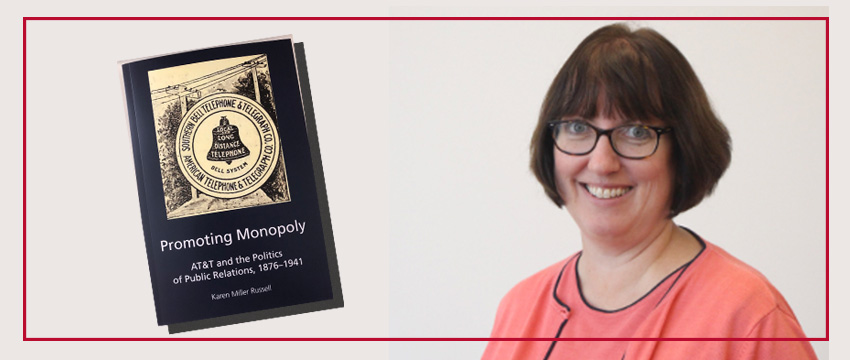Russell uncovers earliest known corporate PR practitioner in new book

Russell uncovers earliest known corporate PR practitioner in new book
Karen Russell, a Jim Kennedy New Media Professor at Grady College, has written a new book, “Promoting Monopoly: AT&T and the Politics of Public Relations, 1876-1941.”
“Promoting Monopoly,” examines the publicity efforts of the competitive industry from the invention of the telephone in 1876 through its early years when Alexander Graham Bell’s patents expired and the fight to control the market became heated. The book examines what is described as “one of the earliest and most effective public relations programs of its time,” along with the discovery of AT&T’s first publicist and the first known corporate public relations practitioner in the U.S., William A. Hovey.
Russell, an associate professor in public relations and a Josiah Meigs Distinguished Teaching Professor, is also the author of “The Voice of Business: Hill and Knowlton and Postwar Public Relations.”
Following are some excerpts from an interview with her about the new book:
Grady College: Can you provide a brief summary of the “Promoting Monopoly”?
Karen Russell: “Promoting Monopoly” is a history of public relations at AT&T, showing how corporate publicity helped build the company and, at the same time, how the company helped to create the formal practice of U.S. corporate PR. It starts with the earliest publicity stunts by the inventors in 1876 and continues to World War II, by which time AT&T was well established as the telephone monopoly in the United States.
The thing I’m most excited about is that I identified a previously unknown publicist, William A. Hovey, who started doing publicity work for AT&T in 1886. That makes him the earliest known corporate practitioner in U.S. public relations history—I’m not saying he was the first, but the first we know about so far. His story is my favorite part of the book, because it means that corporations cared about and systematically tried to improve their reputations and communication earlier than anyone realized.
I also learned that James Ellsworth, who created the Information Department in 1910, played a far more significant role in the development of a sophisticated public relations and advertising program than scholars previously understood. For example, he was one of the earliest U.S. corporate practitioners to embrace film as a medium for conveying messages to the public, and he championed the development of a benefits program because he understood the PR implications of having satisfied employees.
GC: Why did the topic of a monopoly and the public relations surrounding it catch your interest?
KR: Some scholars have argued that corporate PR is inherently political by nature. A monograph about one company can’t prove that’s the case with all corporate PR, but it allowed me to analyze how public relations was deeply politically motivated in the case of the telephone industry.
AT&T is well known for Arthur Page, who was identified as one of the most important PR practitioners in American history. Some members of the Arthur Page Society approached me about the possibility of doing a book on the company to understand Page’s approach and influence better. The Society gave me a grant to do the original round of research, which included visits to the AT&T corporate archives, the Page Society archive, and the Mass Communication History Center at the Wisconsin Historical Society. I was fortunate to get a fellowship from the college to work on it for a semester to continue my research. This time allowed me to focus more on the company before Page started work there and put his contributions into the larger context of corporate history and culture. Finally, the contract through the AEJMC Peter Lang Scholarsourcing program published the project.
GC: What did you learn in your research from this era that is still applicable/relevant to public relations professionals today?
KR: Perhaps the most surprising thing I learned was how intertwined early corporate publicity and advertising were. We think of the convergence of advertising and public relations as a 21st century phenomenon driven by digital communication, but actually my research showed it’s a return to early corporate communication practice. James Ellsworth, who built the company’s Information Department after he started working at AT&T in 1908, supervised both the advertising and the publicity programs and saw them as all part of the same messaging system.
Another thing that still resonates today is the importance of sponsored content. In its earliest years, starting in 1903, AT&T’s corporate publicity program focused on getting syndicated content shared in newspapers around the country, preferably without anyone knowing they had created the stories. Later the company used advertising directly, to promote its messages, and indirectly, to pressure newspapers to run publicity handouts as news. By the 1920s James Ellsworth and other executives were committed to identifying AT&T as the source of such information, but it does remind me of the debates we’re having today about native advertising and other forms of sponsored content, and how corporate sponsorship of news should be identified for readers.